After who knows how many days of mind-numbing, spirit-sapping driving, we are in Golmud, China. Three more days and another 1,000km to go to reach Lhasa. Behind us stretch hundreds upon hundreds of kilometers of drab and dreary Taklamakan Desert, through which we drove under a pall of dense, yellow-grey smog that lay thick from the near to the far horizon. We coughed and wheezed our way through it, eyes watering. We drove on and on, slept, awoke and it was always there. The culprits, coal-fired power plants, were easy to spot, smokestacks spewing black smoke.
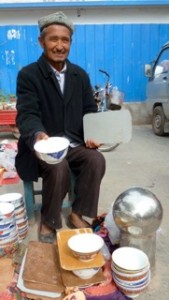
In the 2,800km we have slogged since Kashgar, we had to go round thousands of trucks, rumbling, overloaded, toward the Kyrgyz or Kazak border. We have been on the Taklamakan Highway ( as I call it) pretty much the whole way, and for most of the way it’s been spanking new, gorgeously tarmac’d, multi-lane highway, bounded by baby blue railing on all sides to the point where if an exit were missed it might be another hundred kilometers before one could find a way off. It’s been a wearying, uninspiring, distressing time, as we imagine there must be something of interest or curiosity or charm or, dare I say, beauty to alleviate the drudgery that driving has become on this stretch of the trip. But there isn’t.
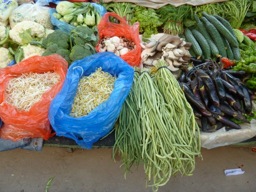
Every now and then we must detour around an incomplete section of the highway, and it is on these re-routes that we pass, with sporadic frequency, through rest stops for trucks. These are actually a 1-2 km strip of tire repair stalls interspersed with food stalls interspersed with melon vendors, and we must run the gauntlet. The whole lot are covered in diesel soot, the earth blackened with spilled oil and fuel. Depending on the time of day, the place may be bustling with truck drivers repairing various mammoth bits of their trucks, alongside small brasiers smoking with the fat from mini-kebabs. Plastic chairs will be set to plastic cloth-covered tables at which sit a few men slurping noodles or soup from large china bowls, a tin kettle of tea sitting on the table, too. Small children play among the stationary trucks, bouncing on a bright inflated ball, or running after one of the tiny dogs with sooty feet that populate these places. If it’s early in the day, the vendors and their family will be asleep on narrow cots outside their stalls under pink or floral quilts, head resting on their arms.
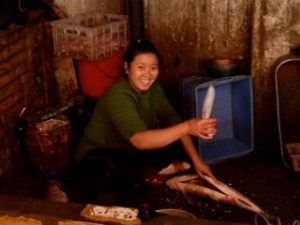
I have had to come to terms with the fact that what I will be seeing of China will not be things of beauty, but rather many things that are disturbing, ugly, depressing, which leave me drained rather than uplifted. For the most part, I see desert a-flutter with plastic and garbage from the small green tents in which road workers live. These workers may be men sweeping gravel off the road, or women in pink kerchiefs following their flag-bearing leader single file down the middle of the road, laying a thin strip of glue onto the asphalt, to which will be stuck the white strip that demarcates one lane from the other.
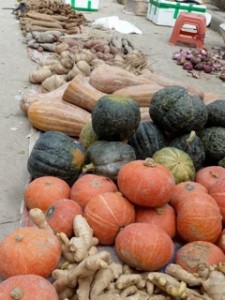
On the nicer side, there are the miles of burgundy peppers laid out like a kilim carpet, to dry on the desert gravel. An enormous hay truck roars toward us and as it passes we spot a tiny lime green car perched crosswise atop a load of wobbly hay. A small herd of fat Bactrian camels nibbles at the seemingly bare desert ground. On a detour that takes us for many kilometers through villages of mud brick one-story huts, we pass tricycle carts hauling 10 sheep packed in the 4×6 cart, well, like sheep; another is full of red chickens in crates. On detours, the narrow road may be lined with tall, slender poplars that are ideal for hiding speed cameras. We are stopped several times, further delaying us on already frustratingly long days. The police are clever, placing wood cutouts of their cars in parking areas and painted silhouettes of themselves at fake checkpoints.
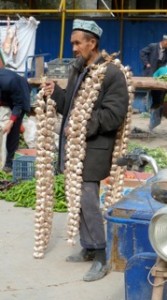
The people in the western regions of China are largely Uygher (ooy-ghur) and as such maintain many of the same foods and traditions as the Kyrgyz and Tajiks. We stop along one village strip to buy bread from a tandoori oven baker. I time him and it takes him only a minute to roll out one of the 140 dough balls his wife has prepared, mash it onto a large plate to encrust it wish sesame seeds, salt and onion, pound it with a round, pin-headed mortar to make a pleasing pattern, sprinkle it with water and slap it inside the oven.
Another couple of minutes and he uses a long pick to extract a golden 10-inch round, which his wife swiftly brushes with oil. Back it goes for one more minute and then it’s picked out and flung onto the concrete counter around the oven, where I grab it and rip off a hot bit of crust which burns my fingers and singes the roof of my mouth. But I have no regrets!
Please read Part 2 for more on our time in Western China.
-Dina










